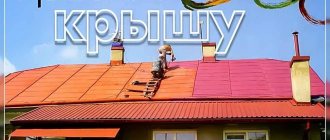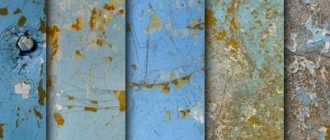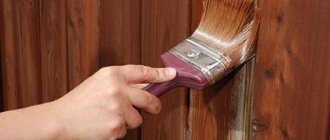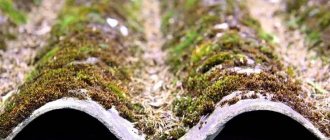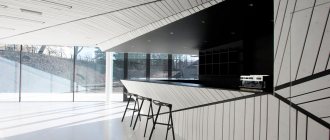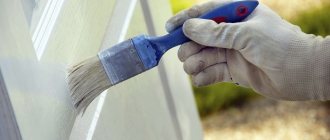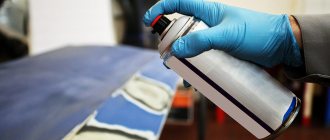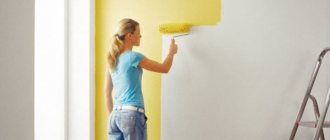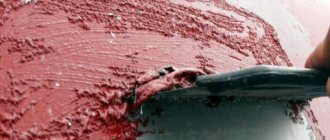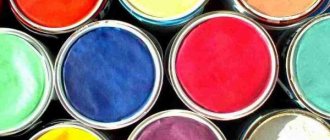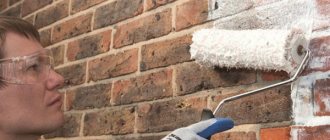Glossy paint is used to decorate many surfaces in the house. Its popularity is noted among both professionals and home craftsmen. Water-based paint is most often used to create a glossy ceiling surface in rooms of different functional areas. This is what we will talk about today.
Advantages and disadvantages of water-based gloss paint
Such compositions have been known to man for a long time. Now their choice in construction stores is incredibly wide. In order to choose exactly the right composition, you need to familiarize yourself with the advantages and disadvantages of this type of substance. So, the positive features of water-based paints include:
- Simplicity and ease of use due to which even a novice master can cope with coloring. The composition can be applied in any way, from a brush to a professional spray gun.
- Budget cost. Compared to oil-based and other paints, water-based paints are much cheaper. Important! If the surface is large, then it can be painted in stages without fear of spoiling the final appearance.
- Resistant to high humidity conditions.
- Resistant to abrasion and mechanical stress. Such a surface remains in its original form for a long time.
- A painted wall is not subject to rapid contamination, since it is difficult for dirt to stick to the gloss.
- Easy to maintain and the ability to wet clean the surface.
- Visual increase in space due to the effect of reflection from gloss.
- Obtaining a stable, beautiful glossy effect over the entire surface.
- High indicators of environmental friendliness and safety during application. Water-based paint is not harmful to health; it does not emit harmful fumes during or after use. This means that it is not necessary to wear a respirator; there is no danger that the volatile substances from the composition will have a toxic effect on the human body or ignite inside the can. In addition, the person painting will not experience headaches or associated symptoms while carrying out the work.
- After drying, the finished surface will perfectly allow air to pass through it, unlike similar compositions that form a dense crust. In a room renovated in this way, the correct microclimate is formed, which makes it easier to breathe.
- High proportion of adhesion to various materials.
- Easy to color even on your own.
Among the negative aspects of using water-based paint are high consumption rates. So, in order to achieve the highest quality coating, you will need to apply several layers at once, which affects the required quantity. The water-based composition has greater fluidity, which leads to the formation of drops and splashing during the painting process.
Important! The problem of spattering can be corrected by using modern paint sprayers.
It is worth noting that the glossy surface, after drying, can show all, even the smallest, surface defects, so it must be applied strictly to a prepared and leveled base.
Matte paint - application features
When decorating premises for various purposes, matte paints are used; they allow you to hide minor defects (cracks, dents). The material is universal and does not reflect light waves well.
Suitable for painting ceilings and walls in the following rooms:
- hallways;
- children's rooms;
- bedrooms;
- halls;
- hospitals;
- laboratories;
- offices.
The recommendations indicated by the manufacturer on the label inform about the purpose of the material. To get the best result, you need to listen to the advice of experts .
Compositions intended for dry areas should not be used in kitchens and bathrooms. Some types are resistant to dry abrasion, so you can use a vacuum cleaner to remove dust.
Coatings that form a thin film after application can be wiped with a damp cloth after drying without fear of damaging them. Some materials are resistant to frequent washing.
To ensure that the pigment is even and holds firmly, the base should be prepared before applying the composition:
- clean from dust and dirt;
- remove existing old paint;
- putty over uneven areas;
- if necessary, sand it.
What matters is the type of material chosen and the characteristics of the base on which the paint will be applied. A second coat may be required to achieve a deeply matte finish. It is possible to obtain the desired shade using a color additive.
Advantages and disadvantages
Interior matte paints are durable and have a long service life.
Main advantages:
- suitable for rooms with a large flow of people (public places, waiting rooms, corridors, etc.);
- the coating does not fade and remains saturated;
- do not contain harmful substances;
- no glare from lighting;
- able to cover the previous color after applying 2-3 layers;
- no unpleasant odor;
- the color palette allows you to use the coating regardless of style;
- depending on the ingredients, can be used as interior or façade;
- a high degree of dispersion makes the lighting uniform over the area of the room;
- easy to apply;
- have an affordable price.
Matte paints in the interior.
The versatility of the paint does not eliminate its shortcomings:
- does not withstand contact with moisture (the coating cannot be washed);
- damage (scuffs or scratches) becomes visible;
- settling on the surface, small dust particles require frequent cleaning (with a vacuum cleaner or brushes with soft bristles).
Tips for high-quality gloss paint application
In order for the finished surface to look as impressive as possible, you should follow some tips that will help you make it look like this:
- For painting, use a roller with a pile of up to 4 mm. This guarantees that the composition will apply more evenly, forming a perfectly flat surface after drying.
- The room where the work is being carried out must have good lighting so that the result can be assessed immediately and incorrect strokes can be corrected in the process.
- When applying, be sure to monitor the thickness of the composition, since if it is too thick, the layer may be uneven.
- In order for different areas of the layers to be the same, it is worth applying more paint to a dry roller than to an already impregnated one.
- To create a uniform layer for the composition, a special trough with a ribbed layer is used, which will help remove excess dye.
Preparatory work depending on the type of surface
The first step to a flawless painting result is surface preparation. General rules:
- Remove furniture, household appliances, and other items from the premises. Cover heavy items with film. Remove the lighting fixtures.
- Remove old coating.
- Apply primer. It reduces paint consumption and improves adhesion to the surface. The primer is selected taking into account what material needs to be painted, and on the same basis as the paint and varnish. For example: an alkyd enamel was chosen for a concrete ceiling - buy an alkyd primer for concrete.
Drywall and gypsum fiber sheet (GKL and GVL)
Preparing gypsum plasterboard and gypsum fiber board ceilings for painting:
- Using a spatula, move it along the places where the sheets of drywall are attached and push down the heads of the screws on which it will catch.
- Wipe the ceiling with a dry cloth.
- Apply acrylic putty primer to all corners using a brush.
- Apply primer to the entire surface with a roller. After drying, apply a second layer.
- 24 hours after completion of priming, prepare the seams between the sheets for filling with putty. Jointing is often required.
- Cover the joints with putty mixture and seal with serpyanka or reinforcing tape. Apply a second layer of putty to the seams, wait until it dries, and sand with sandpaper.
- Caulk all the drywall. After drying, remove any unevenness with a spatula. Cover the floor and walls with film, put on a mask or respirator, and sand the ceiling with a special grater.
- Apply the second (finishing) layer of putty. The surface should be perfectly flat. Another coat may be needed. After drying, sand the ceiling again with a float or sandpaper with the finest grain. For glossy paint, sand especially carefully.
- Remove dust.
- Apply a coat of paint primer and leave to dry for 24 hours.
Concrete ceilings
Preparing to paint a concrete ceiling:
- Inspect the surface. Knock down the protrusions with a hammer or hammer drill, and widen the cracks with a knife.
- Prime all defects and fill with repair mortar. You can use painting fiberglass.
- Apply 2 coats of primer (the second after the first has dried).
After priming, complete the preparation of the ceiling in the same way as a plasterboard ceiling (see points 7 - 10).
Wooden surface (plywood, chipboard, fiberboard)
Preparing to paint a wooden ceiling:
- Sand the surface with coarse sandpaper, an angle grinder or a drill with a special attachment.
- Apply impregnation - antiseptic (against rot, mold, etc.), if necessary, fire- and moisture-proof.
- Fill cracks with wood putty.
If the ceiling is new, without defects, then two layers of primer or drying oil (under oil-based paints and varnishes) are sufficient for the paint. If there is damage, the wood is puttied in several layers, carefully sanding each one. A paint primer is applied over the finishing layer of putty.
Ceilings made of plywood, chipboard and fiberboard are prepared in the same way. First, (as on drywall), the heads of the screws are recessed. Putty is used on wood, a special primer is used for chipboard, fiberboard and plywood.
Attention! Glossy paint for ceilings made of wood, plywood, boards based on shavings and sawdust is the worst option, since it is impossible to achieve a perfectly smooth surface on them.
Criteria for choosing glossy paint
Construction stores currently offer a huge variety of glossy compounds. Among all the diversity, you can get confused, so it’s better to familiarize yourself in advance with the criteria by which the correct composition is selected:
- Covering power. This indicator indicates the consumption and required amount of material for decorating a particular area.
- Masking effect of paint. As previously mentioned, glossy water-based paints do not mask surface defects well, so special attention should be paid to leveling the base before application.
- Volume of a paint can. Here it is important to start from what dimensions will need to be painted and choose paint in a convenient volume.
- Performance and quality characteristics of the resulting coating. It is imperative to correlate the indicators that the paint gives with the desired results.
- Price. A lot also depends on this indicator. Water-based paint allows you to save money, as it costs a little less than non-water-based paints.
Make the ceiling glossy
An excellent solution when you need to visually raise a low ceiling. Try painting the walls and ceiling one light shade. Just choose a matte finish for the walls and a glossy finish for the ceiling. The reflective texture of the high-gloss paint will make the ceiling appear much higher than it actually is.
Dufa
These paints and varnishes are considered one of the best. They are preferred by professional repairmen. This paint is usually sold in 10 liter plastic containers. Its average cost is approximately 3,500 rubles.
Dufa paint is distinguished by high hiding power, strength and reliability of the resulting coating. It allows you to create an unobtrusive glossy surface that can visually increase the dimensions of a small room. The color turns out snow-white, but the paint can be tinted to obtain the desired shade.
Technology
Taking into account the type of plaster base, glossing is performed 30-60 minutes after spreading, trimming and leveling the mortar, as the composition will begin to gradually set. Glossing is performed in a circular motion using a special grater and sponge. During the processing process, the surface layer of decorative plaster is “rejuvenated” or “soaked.” The gypsum milk that is released from the plaster layer must be leveled with spatulas for facade work.
To obtain a glossy finish, after 4-5 hours, but no more than a day after distributing the composition, the plaster should be moistened again, “soaked” with a sponge and smoothed. Having completed the procedure and waited until the surfaces are completely dry, you can begin gluing wallpaper and distributing textured paint.
Caparol
This paint and varnish composition is highly durable, therefore it is most often used for painting surfaces in country houses, as well as in the bathroom. The manufacturer specializes in the production of silicone compounds that, when applied correctly, can hide minor surface defects.
The covering power of the material is quite high, which allows for perfect coverage even in 1 layer. The finished surface is easy to clean and has dust- and dirt-repellent properties. Moreover, it is also water-repellent.
Glossing gypsum plaster
Glossing of gypsum plaster is considered a popular method when applying this finishing layer to walls using mechanized means. In most cases, mixtures produced under the brands Forman 12 or JetBau are used for distribution using special equipment. Such compositions are often white or beige in color.
The best-selling mixture for machine application, Knauf MP 75, in the central regions of Russia is produced in a gray version, when in the south it is light. This is explained by the type of gypsum deposits and the technology of their extraction.
When the surface is dry, you can start gluing wallpaper without putty. This will reduce costs and reduce the time for repair work. Therefore, this action is in demand in premises where it is important to complete the work quickly and inexpensively.
If the walls are to be puttied, there is no need to polish them, because... this will lead to coverage failure. As a result, the putty will no longer adhere normally to the surface and will begin to roll off.
Cement compositions do not require glossing, since they do not contain a gypsum component. In some cases, surfaces are treated with polyurethane floats, which are not subject to wear.
Tikkurilla
This brand produces a variety of paints and varnishes, including water-based gloss paints. The company has proven itself well and has been on the market for many years, which leaves no doubt about the quality of the materials.
The paint has all the advantages that are so important to consumers:
- Purity of color.
- Wide possibilities for tinting.
- Durability of the resulting coating.
- Strength.
- Resistance to ultraviolet radiation.
- High technical and quality characteristics of the composition.
This paint has one drawback - its high cost, but it is fully justified by its high quality.
Advice! When purchasing, you need to pay special attention to the place where the paint is produced, since the paint produced in Finland is of high quality.
Possible problems during painting
When using glossy ceiling paint, the following difficulties may arise:
- the coloring material may be thickened, and then application becomes problematic. To avoid this effect, you should not purchase material sold on street markets. On frosty days, the paint freezes and thickens. When purchasing, pay attention to the expiration date of the product;
- Unsightly streaks may occur during paint application. In this case, when applying the composition with a roller, it is necessary to move it slightly to the side. This way the paint will be distributed more evenly and clumps will not accumulate;
- To avoid sagging of the paint composition, you need to roll the roller along the ceiling while there is liquid in it. You don't need to take a lot of paint at one time.
Advice: if the paint turns out to be frozen, then there is a way out. The composition needs to be strained, and there will be no clots. Next, the coloring composition is thoroughly mixed and a little solvent is added.
"Snowball"
This paint has the best price-quality ratio among all those mentioned. The paint is suitable for any type of surface. Thanks to its high hiding power, it allows painting in one layer. The composition allows high-quality combination of materials with different textures, which in some cases is necessary.
Almost all compositions of this paint are not resistant to moisture, but they are environmentally friendly and hypoallergenic. It is important to remember that the specified paint consumption parameters, which are indicated by the manufacturer, differ by 2 times from the actual ones.
Advantages of glossing for walls
Glossing plaster is a popular method of finishing wall surfaces, which has a number of undeniable advantages:
- When the procedure is carried out correctly, the walls become smooth and suitable for applying various finishing materials.
- The method reduces repair costs, because the need for additional putty is eliminated.
- The leveling process becomes fast and efficient.
Plaster is characterized by higher strength properties than putty, which requires sanding. In addition, the plaster layer is thicker than putty and remains on the wall even when old wallpaper is peeled off.
However, in addition to the positive qualities, this method also has disadvantages:
- Not all gypsum plasters are suitable for glossing. Therefore, it is worth using high-quality material with a high content of natural gypsum.
- To perform such a procedure, experience and skills are required. It is quite problematic for a novice master to complete the task. You will need to watch training videos or get acquainted with examples of the work of other specialists.
- Glossing is not always suitable for painting, since this option requires puttying.
TEX
The paint is water-based and provides high-quality surface coverage. The composition is not expensive in terms of cost, which makes it accessible for use by home craftsmen.
Among the negative features are low coverage, high consumption and strict requirements for priming the base surface.
Wall surface requirements
Finishing walls to eliminate defects is a long and painstaking process that requires special skills and dexterity. Before you start work, you need to determine the type of finishing layer you are planning - gluing wallpaper or applying a paint mixture.
Leveling gives the walls a number of special characteristics, but requires several preparatory steps.
The master needs to do the following:
- Before leveling, the surface of the walls should be cleaned of dirt, old finishing coating and dust.
- Then a primer with deep penetration and antiseptic additives must be applied to the wall surface. This will prevent the formation of fungus and mold in different parts of the wall.
- If necessary, a reinforcing mesh is fixed to the surface.
- Next, a plaster solution is applied, and leveling is carried out using beacons and a rule.
- Also, the requirements for glossing include priming the plaster, puttying and grinding with troweling of surfaces. Before fixing wallpaper or painting, you need to prime it.
If gypsum-based plaster is used, leveling is carried out without applying putty.
